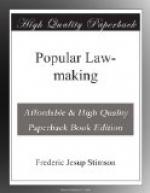The industrial condition of the sex in American cities may be summed up with the general phrase “absolute equality of opportunity,” with a certain amount of special protection. Women are nearly universally required to be given seats in factories and stores, and the laws specially protecting their periods of employment have just been sustained as constitutional in the States of Illinois and Oregon and the Supreme Court of the United States. On the other hand, we are far behind European countries in legislation to protect their health or sanitary conditions. The most radical effort at legislation ever made was undoubtedly that Connecticut bill forbidding employment of married women in factories, which, however, did not become a law. The recent reports of Laura Scott to the American Association for Labor Legislation, on Child Labor, 1910, and the Employment of Women, 1909, have already been referred to. From the former, which appeared as we are going to press, we learn that there are prohibited occupations to children in all the States without exception—a statement which certainly would not have been true some years since. These prohibited groups of employment are generally, to male and female, dangerous machinery and mines, and to females also saloons; and there is nearly universally a limitation of all labor to above the age of twelve or fourteen for all purposes, and to above fourteen or sixteen for educational purposes, besides which there is a very general prohibition of acrobatic or theatrical performances. Girls are sometimes forbidden to sell newspapers or deliver messages for telegraph companies or others. Compulsory education is, of course, universal, and the machinery to bring it about is generally based upon a system of certificates or cards, with truant officers and factory inspectors.
According to the encyclopaedias, some five hundred thousand women were employed in England about twenty years ago, of whom about three hundred thousand were in the textile mills. In Massachusetts alone there were two hundred and eight thousand women employed, according to the last State census. Neither of these figures include the vast class of domestic service and farm labor. The inclusion of this would swell the proportion of adult women employed in gainful occupations to at least one in four, if not one in three. Congress itself has recently been investigating the question whether “home life has been threatened, marriage decreased, divorce increased out of all proportion, and the birth rate now barely exceeds the death rate, so that the economic and social welfare of the country is menaced by this army of female wage earners” (see Boston Herald, April 2, 1908). It appeared that in 1900 one million seven hundred and fifty thousand children were at work between the ages of ten and fifteen, of whom five hundred thousand were girls. This and other considerations have led to the movement for national child-labor laws already discussed.




